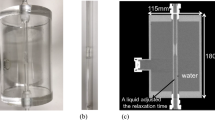Abstract
In this study, we quantitatively compared relaxation enhanced compressed sensing (RECS-3D MERGE) with conventional 3D MERGE techniques on blood suppression efficiency, wall-lumen contrast and plaque burden measurement for carotid atherosclerotic imaging in equal scan time. Twelve patients were recruited in the study. RECS-3D MERGE and conventional 3D MERGE were implemented. 2D DIR-FSE was carried out as a reference standard. The lumen signal-to-tissue ratio (STR) was used as the quantitative measure of blood suppression efficiency. The contrast-to-tissue ratio (CTR) was used as the quantitative measure of wall-lumen contrast. Vessel lumen area (LA) and wall area (WA) were measured for morphological comparisons. The lumen STR of RECS-3D MERGE was significantly lower than that of 3D MERGE while the wall-lumen CTR of RECS-3D MERGE was significantly higher. There were no significant differences in plaque burden measurements between RECS-3D MERGE and 2D DIR-FSE. For comparison between conventional 3D MERGE and 2D DIR-FSE, there were no significant differences in LA measurement. However, the WA of 3D MERGE was significantly larger. The RECS-3D MERGE sequence achieved more sufficient blood suppression and higher image contrast without prolonging the scan time. These improvements lead to more accurate morphological measurements of carotid atherosclerotic imaging.
Similar content being viewed by others
References
Balu, N., Chu, B., Hatsukami, T.S., Yuan, C., and Yarnykh, V.L. (2008). Comparison between 2D and 3D high-resolution black-blood techniques for carotid artery wall imaging in clinically significant atherosclerosis. J Magn Reson Imag 27, 918–924.
Balu, N., Yarnykh, V.L., Chu, B., Wang, J., Hatsukami, T., and Yuan, C. (2011). Carotid plaque assessment using fast 3D isotropic resolution black-blood MRI. Magn Reson Med 65, 627–637.
Block, K.T., Uecker, M., and Frahm, J. (2007). Undersampled radial MRI with multiple coils. Iterative image reconstruction using a total variation constraint. Magn Reson Med 57, 1086–1098.
Candès, E.J., Romberg, J.K., and Tao, T. (2006a). Stable signal recovery from incomplete and inaccurate measurements. Comm Pure Appl Math 59, 1207–1223.
Candès, E.J., Romberg, J., and Tao, T. (2006b). Robust uncertainty principles: Exact signal reconstruction from highly incomplete frequency information. IEEE Trans Inform Theor 52, 489–509.
Corti, R., and Fuster, V. (2011). Imaging of atherosclerosis: magnetic resonance imaging. Eur Heart J 32, 1709–1719.
Donoho, D.L. (2006). Compressed sensing. IEEE Trans Inform Theor 52, 1289–1306.
Fan, Z., Zhang, Z., Chung, Y.C., Weale, P., Zuehlsdorff, S., Carr, J., and Li, D. (2010). Carotid arterial wall MRI at 3T using 3D variable-flip-angle turbo spin-echo (TSE) with flow-sensitive dephasing (FSD). J Magn Reson Imag 31, 645–654.
Gamper, U., Boesiger, P., and Kozerke, S. (2008). Compressed sensing in dynamic MRI. Magn Reson Med 59, 365–373.
Koktzoglou, I., and Li, D. (2007). Diffusion-prepared segmented steady-state free precession: application to 3D black-blood cardiovascular magnetic resonance of the thoracic aorta and carotid artery walls. J Cardiovasc Magn Reson 9, 33–42.
Li, B., Dong, L., Chen, B., Ji, S., Cai, W., Wang, Y., Zhang, J., Zhang, Z., Wang, X., and Fang, J. (2013). Turbo fast three-dimensional carotid artery black-blood MRI by combining three-dimensional MERGE sequence with compressed sensing. Magn Reson Med 70, 1347–1352.
Li, B., Li, H., Li, J., Zhang, Y., Wang, X., Zhang, J., Dong, L., and Fang, J. (2015). Relaxation enhanced compressed sensing three-dimensional black-blood vessel wall MR imaging: preliminary studies. Magn Reson Imag 33, 932–938.
Li, B., Li, H., Kong, H., Dong, L., Zhang, J., and Fang, J. (2017). Compressed sensing based simultaneous black- and gray-blood carotid vessel wall MR imaging. Magn Reson Imag 38, 214–223.
Li, F., and Wang, X. (2017). Relationship between Framingham risk score and subclinical atherosclerosis in carotid plaques: an in vivo study using multi-contrast MRI. Sci China Life Sci 60, 23–27.
Lustig, M., Donoho, D., and Pauly, J.M. (2007). Sparse MRI: the application of compressed sensing for rapid MR imaging. Magn Reson Med 58, 1182–1195.
Murphy, M., Alley, M., Demmel, J., Keutzer, K., Vasanawala, S., and Lustig, M. (2012). Fast l-SPIRiT compressed sensing parallel imaging MRI: scalable parallel implementation and clinically feasible runtime. IEEE Trans Med Imag 31, 1250–1262.
Roger, V.L., Go, A.S., Lloyd-Jones, D.M., Benjamin, E.J., Berry, J.D., Borden, W.B., Bravata, D.M., Dai, S., Ford, E.S., Fox, C.S., et al. (2012). Executive summary: heart disease and stroke statistics—2012 update. Circulation 125, 188–197.
Steinman, D.A., and Rutt, B.K. (1998). On the nature and reduction of plaque-mimicking flow artifacts in black blood MRI of the carotid bifurcation. Magn Reson Med 39, 635–641.
Wang, J., Yarnykh, V.L., Hatsukami, T., Chu, B., Balu, N., and Yuan, C. (2007). Improved suppression of plaque-mimicking artifacts in black-blood carotid atherosclerosis imaging using a multislice motion-sensitized driven-equilibrium (MSDE) turbo spin-echo (TSE) sequence. Magn Reson Med 58, 973–981.
Wang, X., and Zhou, X.J. (2017). Magnetic resonance imaging in personalized medicine. Sci China Life Sci 60, 1–4.
Yarnykh, V.L., and Yuan, C. (2002). T1-insensitive flow suppression using quadruple inversion-recovery. Magn Reson Med 48, 899–905.
Acknowledgements
This work was supported by the National Natural Science Foundation of China (81760311), Science and Technology Plan Foundation of the Jiangxi Provincial Health and Family Planning Commission (20184009), and Chinese Medicine Research Foundation of the Jiangxi Provincial Health and Family Planning Commission (2017A152).
Author information
Authors and Affiliations
Corresponding author
Ethics declarations
Compliance and ethics The author(s) declare that they have no conflict of interest.
Rights and permissions
About this article
Cite this article
Li, B., Li, H. & Dong, L. Quantitative comparisons between relaxation enhanced compressed sensing 3D MERGE and conventional 3D MERGE for vessel wall imaging in equal scan time: preliminary studies. Sci. China Life Sci. 62, 1683–1691 (2019). https://doi.org/10.1007/s11427-019-9589-5
Received:
Accepted:
Published:
Issue Date:
DOI: https://doi.org/10.1007/s11427-019-9589-5




